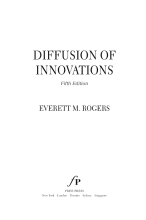Summary Technological Society
- This + 400k other summaries
- A unique study and practice tool
- Never study anything twice again
- Get the grades you hope for
- 100% sure, 100% understanding
Read the summary and the most important questions on Summary Technological Society
-
1 Traditional Perspectives
This is a preview. There are 5 more flashcards available for chapter 1
Show more cards here -
What does Technological Determinism entail?
It tries to understand how a specific technology has had an impact on human action an thought -
What are the 3 traditional perspectives?
Technological Determinism, Linear model, Diffusion model -
What does Diffusion Model entail?
The Diffusion Model is established in 1962 by Rogers. Rogers defines diffusion as a process in which an innovation is communicated through certain channels over time among members of a social system.
When new innovations are invented, diffused and adapted or rejected, leading to certain consequences, social change occurs. -
What are the characteristics of the element innovation(s)?
- Relative advantage (when an innovation is better than its predecessor)
- Compatibility (when an innovation is consistent with needs, values and experiences of the adopter)
- complexity (defines the level of difficulty for using an innovation)
- trialability (describes the basis wherein the adopter can experiment)
- observability (contains the results of adapting to an innovation as seen by others) -
What is the innovation decision process in the diffusion model?
It is the process through which an individual passes from first knowledge of an innovation through its adoption or rejection. -
What are the steps of the innovation decision process?
1: Knowledge (When an individual learns of the existence and gains understanding of the innovation)
2: Persuasion (When an individual forms a favorable or unfavorable attitude towards the innovation)
3: Decision (When an individual engages in activities that lead to a choice to adopt or reject)
4: Implementation ( When an individual puts an innovation into use)
5: Confirmation (When an individual seeks reinforcement of an innovation, individual can reverse this decision if there are conflicting messages about the innovation) -
What does innovativeness entail?
Innovativeness is the degree to which an individual or other unit of adoption is relatively earlier in adopting new ideas than the members of a system. -
Why did Rogers developed the theory, diffusion of innovations?
To explain the phenomena of people adapting to new innovations or products sooner than others. The theory explains how innovation gets adopted over time and by different cohorts. -
What are the five categories of adopters (S curve)
1: Innovators (2,5% first to learn about an innovation)
2: The early adaptors (13,5% opinion leaders, when so called child diseases are gone).
3: Early majority (34% take time to make decision, only adopt when they are convinced there are benefits)
4: Late majority (34% want innovations to be well tested)
5: Laggards (16% "lag of interest" highly resistant to change, want innovation to be mainstream) -
What is the first critique on the Diffusion Model?
Pro-innovation Bias, the implication of most diffusion research that an innovation should be diffused to and adopted by all members of a social system, that it should be diffused rapidly, and that the innovation should be neither reinvented or rejected.
- Higher grades + faster learning
- Never study anything twice
- 100% sure, 100% understanding
































